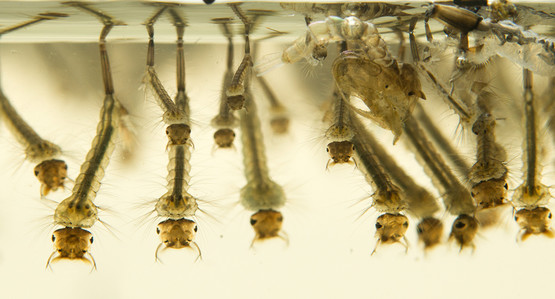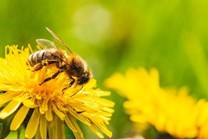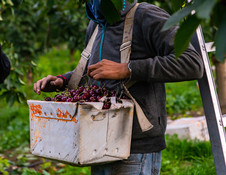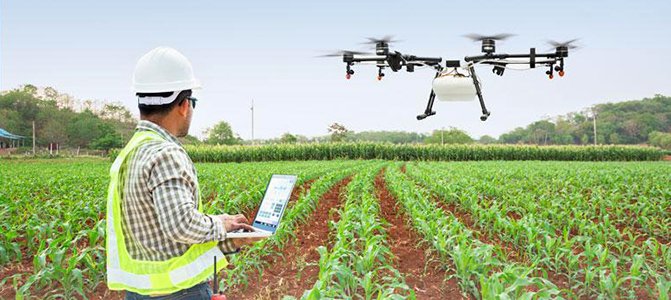|
Having trouble viewing this email? View it as a Web page.

|
|
|
Editor: Kelly Sprute August 25, 2021
Making a Difference
 Mosquito larvae, courtesy of Adobe Stock.
Key to Controlling Mosquitoes May Reside in Their Gut Microbiota
To most people, mosquitoes are a nuisance. To University of Georgia entomologist Michael Strand, learning about their development processes could lead to new approaches in mosquito control. “What our study brought home is that vitamin instability is a key factor in why aquatic organisms like mosquitoes are so dependent on their gut microbiota,” said Professor Strand.
Mosquito larvae develop in small, aquatic habitats like abandoned tires, birdbaths, or flowerpots that can range from abundant and nutrient complete to poor. Regardless of how they get nutrients to grow, mosquitoes and most other animals, including humans, harbor microorganisms in their digestive tracts to form what is called the gut microbiota.
Mosquitoes cannot grow normally beyond the larval stage without a gut microbiota, even when fed nutritionally complete diets. The research for this study was supported by the National Institutes of Health, USDA’s National Institute of Food and Agriculture Hatch Project, and the Pulliam endowment. For more information, read this University of Georgia Newswire article.
|
|

NIFA Celebrates National Honey Bee Day
Bees and other pollinators are crucial to agricultural production across the globe. According to the Food and Agriculture Organization, approximately 35 percent of crop production worldwide is directly affected by these bumbling and buzzing friends. In the United States, more than 100 U.S. grown crops rely on pollinators. In addition to managed honey bees, the U.S. is home to 4,000 native bee species. National Honey Bee Day brings awareness to the importance of honey bees and beekeepers and how essential they are to our food systems. For more information, read this NIFA blog.
A honey bee collecting nectar from dandelion flower. Image courtesy of Adobe Stock.
|

USDA Announces Proposed Framework for Advancing Surveillance for SARS-CoV-2 and Other Emerging Zoonotic Diseases through the American Rescue Plan
The U.S. Department of Agriculture is dedicating $300 million in American Rescue Plan Act funding to conduct surveillance for SARS-CoV-2 and other emerging and zoonotic diseases in susceptible animals and to build an early warning system to alert public health partners to potential threats so they can take steps sooner to prevent or limit the next global pandemic. USDA’s Animal and Plant Health Inspection Service is the lead agency responsible for implementing the early warning system and is inviting public comment on a Strategic Framework that outlines how the Agency will focus its efforts to prevent, detect, investigate, and respond to SARS-CoV-2. For more information, read this USDA press release.
|

COVID-19 Rapid Response Research Early Outcomes
In spring of 2020, the U.S. Department of Agriculture’s National Institute of Food and Agriculture (NIFA) announced a research investment to look at the impact of COVID-19 on American agriculture. NIFA opened its request for applications for research or extension activities focused on developing and deploying rapid, reliable, and readily adoptable COVID-19 agricultural strategies across the food and agriculture enterprise. Through the Agriculture and Food Research Initiative program, NIFA invested up to $9 million for research. For more information, read this NIFA blog.
Consumer at the supermarket, courtesy of Getty Images.
|

USDA Encourages Ag Producers, Residents to Prepare for Tropical Storm Henri
The USDA reminds communities, farmers and ranchers, families, and small businesses in the path of Tropical Storm Henri that USDA has programs that provide assistance in the wake of disasters. USDA staff in the regional, state and county offices stand ready and are eager to help. USDA partnered with FEMA and other disaster-focused organizations and created the Disaster Resource Center. This central source of information uses a searchable knowledge base of disaster-related resources powered by agents with subject matter expertise. The Disaster Resource Center website and web tool now provide an easy access point to find USDA disaster information and assistance. For more information, read this USDA press release.
Global storm from space, courtesy of NASA.
|

NIFA Career Opportunities
We are hiring! The National Institute of Food and Agriculture (NIFA) recruits a diverse group of talented, creative, motivated professionals who are invested in shaping the future of food and agricultural science. We offer a variety of benefits and services to our employees that focus on work-life balance, career enhancement, and health and well-being. NIFA has career opportunities in a variety of scientific disciplines covering engineering, food science, forestry, education, animal and crop sciences, and many other agriculture-related disciplines. NIFA job openings are listed on USAJobs. Current NIFA job openings are for Kansas City, Missouri, or location negotiable after selection.
Lead Accountant (Staff) (GS-13)
Closing Date: 09/02/2021 or when we have received 150 applications
View the merit promotion job announcement (mainly for government employees)
|

Artificial Intelligence Researchers Receive Federal Funding
The Ohio State University (OSU) is now the home base of two federally funded institutes dedicated to advancing artificial intelligence (AI) research. The U.S. National Science Foundation announced the establishment of 11 NSF National Artificial Intelligence Research Institutes, building on the first round of seven institutes funded in 2020. The combined investment of $220 million expands the reach of these institutes to include a total of 37 states. Led by NSF, and in partnership with USDA’s National Institute of Food and Agriculture, the AI Research Institutes will act as connections in a broader nationwide network to pursue transformational advances in a range of economic sectors and science and engineering fields from food system security to next-generation edge networks. For more information, read this OSU article.
Young students of robotics working on a project together, courtesy of Getty Images.
|

Career Advancement Paths for Migrant and Seasonal Farmworkers through New Grant
Three Michigan State University (MSU) partners will help develop career advancement opportunities for migrant and seasonal farmworkers in a new $500,000 U.S. Department of Agriculture grant. This funding supports the Michigan Agriculture and Food System Workforce Advancement Initiative to help migrant and seasonal farmworkers be better trained for Michigan food systems jobs and acquire job skills and experience so they can advance along career paths. Participants in the program will be afforded the opportunity to gain career-ready skills through hands-on training and professional experiences at the academic as well as professional level. This work is funded by USDA’s National Institute of Food and Agriculture. For more information, read this MSU article.
Seasonal farm worker with a full basket of organic sweet black lapin cherries, courtesy of Adobe Stock.
|

Calculating the Economic Impact of Biting Stable Flies to California Dairies
Flies are ubiquitous, disease-carrying pests that annoy everyone, everywhere – and that’s just the species that doesn’t bite. Biting flies, like stable and horn flies, have all the negative attributes of other flies, plus a serrated dagger-like mouthpart to pierce skin and suck blood. They are problem pests in animal agriculture, and new multi-disciplinary research on California dairies has calculated the economic loss caused by stable flies and a defensive behavior cows take to avoid them, called bunching. The Western Integrated Pest Management Center is one of the funders of this study looking at the causes and costs of cow bunching and stable flies on dairies. For more information, read this Western IPM Center article.
Stable fly standing on a green leaf, courtesy of Adobe Stock.
|

Prioritizing Nutrition Security:
NIFA Elevates Youth and Families
Learn about the roles of youth and families in prioritizing nutrition security in an upcoming webinar on August 31 from 3 to 4:30 p.m. ET (2 to 3:30 p.m. CT). Program experts will lead the session sharing their knowledge about NIFA programs that help elevate youth and families in prioritizing nutrition security. Attendees are highly encouraged to ask questions during the live Q&A segment. This event is the third installment of NIFA’s new monthly Nutrition Security Webinar Series. The series is set to feature a broad range of topics and speakers focused on prioritizing nutrition security during and beyond the COVID-19 pandemic. Go online to register or for more information. After registering, you will receive a confirmation email with details on how to join the live session.
Food nutrition security graphic, courtesy of Getty Images.
|

Farm of the Future
NIFA program experts will host an informative Farm of the Future webinar September 9, at 3 p.m. CT. Farm of the Future is a competitive grant program to establish an agricultural test bed and demonstration site. It seeks to launch this rural test bed for precision agriculture, smart automation, data connectivity and transfer to demonstrate best practices in agriculture, forestry, and animal production systems that enhance sustainability and farm profitability. Go online to register for this webinar. After registering, you will receive a confirmation email containing information about joining the webinar.
Webinar graphic, courtesy of Adobe Stock.
|
USDA SBIR Program awards $1 M in Engineering Plant Production and Protection Grants to Small Businesses
NIFA recently awarded 10 grants under the Engineering Plant Production and Protection topic area of the USDA’s Small Business Innovation Research (SBIR) program. SBIR is a highly competitive program that encourages domestic small businesses to enhance crop production in both conventional and organic systems by creating and commercializing engineering technologies that enhance system efficiency and profitability and that protect crops from pests and pathogens in economically and environmentally ways.
Farm of the Future
 Image of farmer with drone in field courtesy of Adobe Stock.
Farm of the Future is a competitive grant program to establish an agricultural test bed and demonstration site. It seeks to launch this rural test bed for precision agriculture, smart automation, data connectivity and transfer to demonstrate best practices in agriculture, forestry, and animal production systems that enhance sustainability and farm profitability. The test bed will evaluate smart technologies to provide accessible, data-driven solutions that support resilient agricultural and value-added practices. The Farm of the Future also seeks to optimize climate-smart agricultural productivity, environmental health, and natural resources management. For more information, read the Farm of the Future funding announcement.

|
|
|
NIFA’s mission is to invest in and advance agricultural research, education, and extension that solve societal challenges. NIFA’s investments in transformative science directly support the long-term prosperity and global preeminence of U.S. agriculture. Keep informed about NIFA, USDA, our land-grant and non-land-grant university partners, and stakeholders with the NIFA Update. Read past issues online, sign up for email updates or follow us on Twitter @USDA_NIFA, #NIFAImpacts or LinkedIn @usda-nifa.
If you wish to submit a news item or information, send an email to NIFAUpdate.
USDA is an equal opportunity lender, provider, and employer.
|
|
|
|